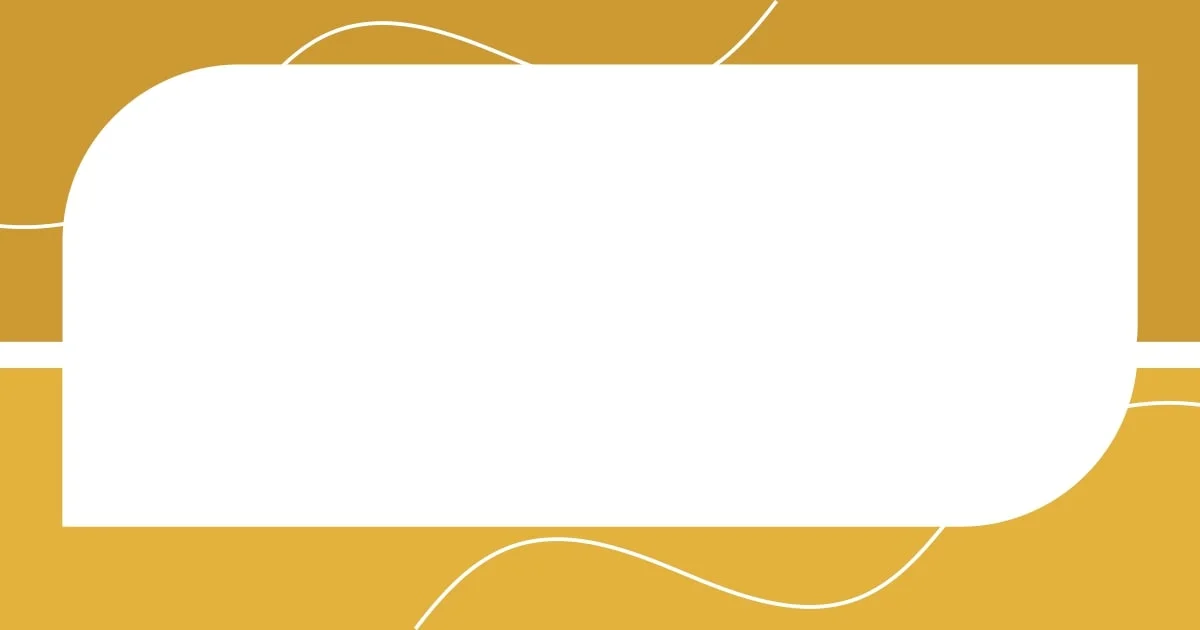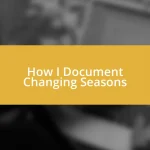Key takeaways:
- Headshots are crucial for creating first impressions, conveying professionalism and personality simultaneously.
- Preparation is vital: wardrobe choices, grooming, expression practice, and mindset all enhance the quality of the headshot.
- Effective lighting and editing significantly improve the impact of a headshot by enhancing features and creating a connection with the viewer.

Understanding the Importance of Headshots
Headshots serve as a visual introduction to who you are, often shaping first impressions long before someone meets you. I remember the moment I updated my own headshot—it was like stepping into a new persona. Imagine someone scrolling through profiles; a captivating headshot might just be the reason they click on yours instead of another!
The significance of a headshot lies in its ability to convey professionalism and personality simultaneously. When I chose the setting and lighting for my last shoot, I wanted to reflect my creative side while maintaining a polished look. Have you ever thought about how a single image can communicate confidence or approachability? It’s fascinating to realize the power behind such a simple decision.
A well-crafted headshot can open doors in both personal and professional realms. I once secured a meeting with a client who remarked that my photo made me appear relatable and trustworthy. Isn’t it interesting how something as straightforward as a picture can influence choices and perceptions?

Preparing for the Photoshoot
Preparing for a photoshoot requires thoughtful consideration, as the right prep can significantly enhance your final image. I’ve learned that taking the time to understand the vibe I want to project is essential. For my last session, I focused on the clothes I’d wear, ensuring they resonated with my personality and profession. It made me feel more at ease, knowing that my attire reflected my authentic self.
Here are some key aspects I recommend focusing on before your shoot:
– Wardrobe Choices: Pick outfits that align with your professional image. Avoid busy patterns that can distract from your face.
– Grooming: Take care of your hair, skin, and nails. Feeling polished boosts your confidence.
– Rest: It might sound trivial, but getting a good night’s sleep before the shoot can drastically improve your appearance.
– Practice Expressions: I often stand in front of the mirror beforehand, trying different smiles and serious looks until I find what feels most natural.
– Mindset: Take a moment to visualize how you want to come across. Positive affirmations can set the right tone before you step in front of the camera.
Small details like these can make a world of difference in capturing that impactful headshot.

Choosing the Right Location
Choosing the right location for your headshot can greatly influence the image you project. From urban backdrops to serene nature settings, each environment can evoke different emotions and messages. I once had a session in a cozy coffee shop. The warm ambiance captured my approachable side, and the casual vibe helped me feel at ease. What’s your favorite spot that resonates with who you are?
Lighting plays a crucial role as well. I’ve found that natural light can soften features and enhance the overall look of a headshot. For my latest picture, I scouted a location near a large window during the golden hour. The soft, diffused light transformed the photo, giving it an inviting quality. What kind of light makes you feel vibrant?
When choosing a location, also consider the background. You want something that complements you without overshadowing your presence. I recall using a simple brick wall backdrop for one shoot. It didn’t take away from my face, but added a touch of urban flair. Think about what speaks to your personality while avoiding distracting elements in the background.
| Location Type | Pros |
|---|---|
| Urban Setting | Dynamic, adds personality, great textures. |
| Nature | Calming, soft lighting, vibrant backgrounds. |
| Studio | Controlled lighting, professional backdrop options. |
| Home/Personal Space | Authentic, comfortable, reflects your style. |

Selecting Appropriate Attire
Selecting the right attire for your headshot can be a game-changer. I remember the time I chose a fitted blazer for a shoot. Not only did it elevate my professional look, but it also gave me a sense of authority that came through in the photo. What colors and styles make you feel empowered?
While it’s important to reflect your professional image, don’t forget about comfort. I once wore a shirt that I thought looked sharp, but it made me feel constricted. The end result? A stiff expression that didn’t resonate with my true self. For me, finding a balance between style and comfort is key—what about you?
Ultimately, selecting outfits that represent your unique personality is vital. I’ve found that classic pieces tend to work well since they’re timeless and generally photograph beautifully. Vibrant hues can add a lively touch, so I often opt for shades that complement my skin tone. Take a moment to consider how your clothing choices align with who you genuinely are; it can truly enhance the impact of your headshot.

Mastering Facial Expressions
Mastering facial expressions is crucial for creating an impactful headshot. I remember prepping for a session and practicing in front of a mirror. It sounds simple, but by exaggerating my smiles and frowns, I discovered the subtle nuances that convey warmth and confidence. Have you ever noticed how a slight tweak in your expression can shift the entire tone of a photo?
For me, it’s all about expressing the real emotions I want to share. I tend to lean towards a relaxed smile because it reflects my approachable nature. But during a more serious project, I had to channel calm professionalism, which felt surprisingly empowering. Have you explored different expressions to see how they resonate with your personal brand?
I often remind myself to focus on my eyes—they tell a story all on their own. I had a session where I thought I was smiling beautifully, but it wasn’t translating because my eyes looked blank. Once I learned to engage my eyes, the transformation was dramatic. How do you ensure your eyes convey the energy you want?

Utilizing Lighting Techniques
Utilizing the right lighting techniques can truly transform your headshot. I vividly recall one shoot where I experimented with natural light filtering through a window. The golden glow on my skin created a warmth and approachability that I didn’t expect, making the final image feel genuine. Have you ever considered how the time of day can affect the mood of your photo?
I also find that using diffused light can soften harsh shadows, lending a more flattering look to facial features. There was a time when I shot with a direct flash; the results were far from flattering. After that experience, I decided to invest in a softbox, and I noticed a significant difference—suddenly, my skin looked more even and vibrant. It’s amazing how a slight change in how the light is directed can elevate your image, right?
Reflecting on my journey, I believe that backlighting can introduce an ethereal quality to headshots, giving depth to the photo. I once had a shoot where the sun was setting, creating a halo effect around me. This unexpected flair gave the image a dreamy touch that couldn’t be replicated with any artificial light. Have you tried playing around with backlighting in your own headshots? The impact might surprise you!

Editing Your Headshot Effectively
Editing your headshot effectively is an art that can significantly enhance its impact. I remember one time I thought I had a perfect shot, but after editing, I realized how a touch of contrast made my features pop. Subtle adjustments, like increasing clarity or reducing noise, can make the difference between an average photo and a standout headshot. Have you ever taken a second look at a photo you thought was good and discovered it could be even better after a little tweaking?
A technique I often use is cropping to focus on what matters most—my face. There was a session where I had a beautifully composed image, but the background cluttered the shot. By cropping it tighter, I drew all the attention to my expression and the story I wanted to tell. It’s fascinating how eliminating distractions can elevate the connection a viewer feels with the image. Have you tried experimenting with different crop styles to see how they change the narrative of your headshot?
When I edit, I also pay attention to skin tones and imperfections. In one particularly memorable session, I noticed how a few minor blemishes were distracting, even though they’re a natural part of me. Using tools to subtly smooth out those distractions without losing authenticity was a game-changer. It’s all about balance—keeping it real while enhancing the overall appeal. How do you navigate the line between enhancing a photo and maintaining an honest representation of yourself?














